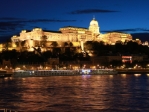
Buda Castle is the royal complex of past Hungarian monarchs. Sitting atop Castle Hill in the picturesque Castle District of Buda, the royal palace was first inhabited by King Béla in the 13th century. After an invasion, he fortified it against further attacks. Its strategic location straddling the Danube offered whoever controlled the city a defensive position and potential control of the main waterway. The castle has a mixture of architectural styles, ranging from Gothic to Baroque. Today it is the country's most important cultural centre, housing numerous museums with the majority of the buildings being historical monuments. The Budapest History Museum contains an exhibition explaining the history of the city, as well as archaeological remains of the palace. Also within the palace complex are the Hungarian National Gallery, the National Library, and the Ludwig Museum.
Address : 1 Szent, György tér
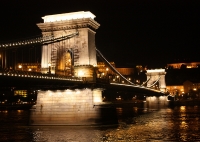
The Chain Bridge was the first stone construction built over the Danube and is the most famous in the city, still featuring its iconic lion statues. Today, nine bridges link Buda to Pest but the Chain Bridge takes pride of place as the city's primary landmark, a magnificent sight when floodlit at night. It owes its existence to Count István Széchenyi who decided to build a permanent crossing after having to wait a week to cross the river to bury his father. The Chain Bridge was built by William and Adam Clark, who also constructed London Bridge. It was considered an amazing feat of engineering when it was opened in 1849. The famous stone lions which guard the bridge were added to the bridge in 1852, miraculously surviving World War II even though the bridge itself was blown up in January 1945 and only resurrected in November 1949.
Address : Roosevelt Square or Adam Clark Square
Website : www.bridgesofbudapest.com/bridge/chain_bridge
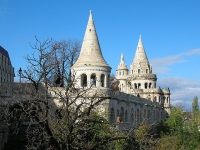
Built in 1905 on the medieval castle walls, the neo-Romanesque ramparts were so named after the city's fishermen whose duty it was to defend this side of the hill during the Middle Ages. But the existing bastion never actually served a defensive purpose. The fairytale-like ramparts are purely ornamental, with gleaming white cloisters and stairways connecting seven turrets symbolic of the Magyar tribes that conquered the Carpathian Basin in the 9th century. Set back from the ramparts is an equestrian statue of King Stephen, a memorial to the founder of the Hungarian nation. The view from Fisherman's Bastion is outstanding, looking over the Danube, the Chain Bridge, and the Parliament Buildings with Pest stretching out into the distance. Floodlit at night, the bastion itself is also a mesmerising sight from across the river. In fact, seeing as entry is free it is definitely worth visiting the Fisherman's Bastion twice, once at night and once during the day.
Address : District I, Szentháromság tér
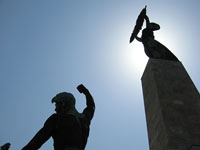
Gellért Hill offers unrivalled panoramic views of the city, taking in both Buda and Pest and the meandering Danube. A monument of a martyred Bishop stands at the base of the hill while on its summit stands the Liberation Monument, a female figure holding aloft the palm of victory dedicated to the memory of troops who died freeing Hungary in 1945. Behind the monument is the Citadella, built after the Revolutions of 1848 to provide military control against further uprisings. The hill is also home to several historic spas, valued for their medicinal qualities. The city's most famous spa, the Gellért Baths, is attached to the grand establishment of the Art Nouveau Gellért Hotel. Here, visitors can relax in the thermal waters of the Roman-styled pool with its lion-headed spouts, surrounded by columns and mosaic patterns, or indulge in private therapeutic treatments or massages.
Address : District XI, Szent Gellért tér 2-6
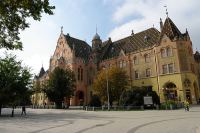
A 53-mile (86km) drive from Budapest, Kecskemét makes for a wonderful short trip from the city. While this garden city is quite large, with more than 100,000 residents, the place has a uniquely small-town charm. Walking around the scenic city centre is pleasant, with the abundance of open squares and avenues peppered with colourful Art Nouveau buildings. There are a number of attractions in Kecskemét that visitors will enjoy, including the distillery tours at the Pálinka Museum, the Hungarian Photography Museum, the Museum of Hungarian Folk Art and Handicrafts, and the beautiful architecture and art collections at the City Hall. The city has existed in some form since at least the 1300s so it is no surprise that it holds many old and hidden gems for visitors.
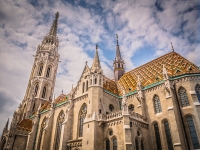
Situated in the centre of the Castle Quarter, the 700-year-old Church of Our Lady is popularly known as Matthias Church. It's named after the nation's famous ruler King Matthias, a patron of learning and the arts. Matthias Church's architecture is a mixture of styles from the various kings, occupations and periods. When the Turks occupied the Castle in 1541 it was converted into a mosque, and the interior walls were whitewashed and painted over with scenes from the Koran. It suffered heavily in the later siege and was restored again in the 19th century, reconstructed in its characteristic neo-Gothic style. Remains of the original medieval frescoes have been discovered underneath the whitewash. The interior is richly decorated with gilded altars, statues, rose windows, and frescoes. Inside is the Church Museum, which gives access to the crypt and a small collection of religious treasures and jewels. A fantastic contrast is formed by the reflection of the Gothic church in the sleek dark glass sides of the contemporary Budapest Hilton alongside. The church remains operational, hosting organ concerts and choir recitals beneath its multi-coloured tiled roof and Gothic spire.
Address : H-1250 Budapest, Pf. 22.
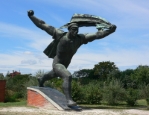
A popular yet bizarre attractions, Memento Park contains the giant figures of the communist era that once filled the streets of Budapest. Among them are the forms of Lenin, Marx, and Engels, as well as memorials to Soviet soldiers and communist martyrs. There are also exhibitions detailing the history of the Soviet occupation in Budapest, contributing to a unique collection of artefacts and a fine location to educate oneself on the nature of communism.
Address : District XXII, corner of Balatoni ut and Szabadkai utca
Website : www.szoborpark.hu
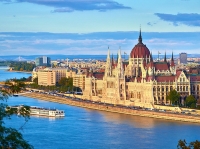
On the bank of the Danube stands one of the world's most beautiful buildings of parliament, an imposing sight and a prominent feature of the city's panorama. With its red dome, white stone lace ornamentation, and spires, it is the city's most decorative structure. Stone lions flank the entrance guarding a rich interior of marble and gold, statues, and columns. Magnificent artefacts are seen on guided tours, including the 1,000-year-old crown of the first Hungarian King. The grand edifice, stretching for 250 metres (820ft) along the embankment, is one of the biggest national assemblies in the world. The tours take between 45 minutes and an hour.
Address : District V, Kossuth Lajos tér 1-3
Website : www.parlament.hu
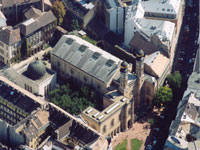
Situated within the charming old Jewish quarter of Pest, the Great Synogogue is one of the largest in the world. Its style is Byzantine-Moorish, with patterned brickwork in the red, blue, and yellow colours of the city's coat of arms. Gilded domed towers, archways, and beautiful windows make this one of Budapest's great landmarks. The splendid interior glitters with lights and gilded arches while balconies line the walls. The ceiling is covered in Stars of David and the floor is tiled in decorative stars. On Jewish festivals, it's packed with Jews from all over Hungary who come to celebrate within its splendour. Next door is the Jewish Museum, containing a Holocaust Memorial Room and relics from the Hungarian Jewish Community. In the courtyard is the Holocaust Memorial in the shape of a weeping willow tree, each metal leaf engraved with the names of those who have passed away.
Address : Dohany utca 2-8 in VII district.
Website : www.greatsynagogue.hu

Travel Guide powered by Word Travels, copyright © 2023 Globe Media Ltd. By its very nature information in this travel guide is subject to change at short notice and travellers are urged to verify information on which they're relying with the relevant authorities. Neither Globe Media Ltd nor Travel Vogue can accept any responsibility for any loss or inconvenience to any person as a result of information contained above.